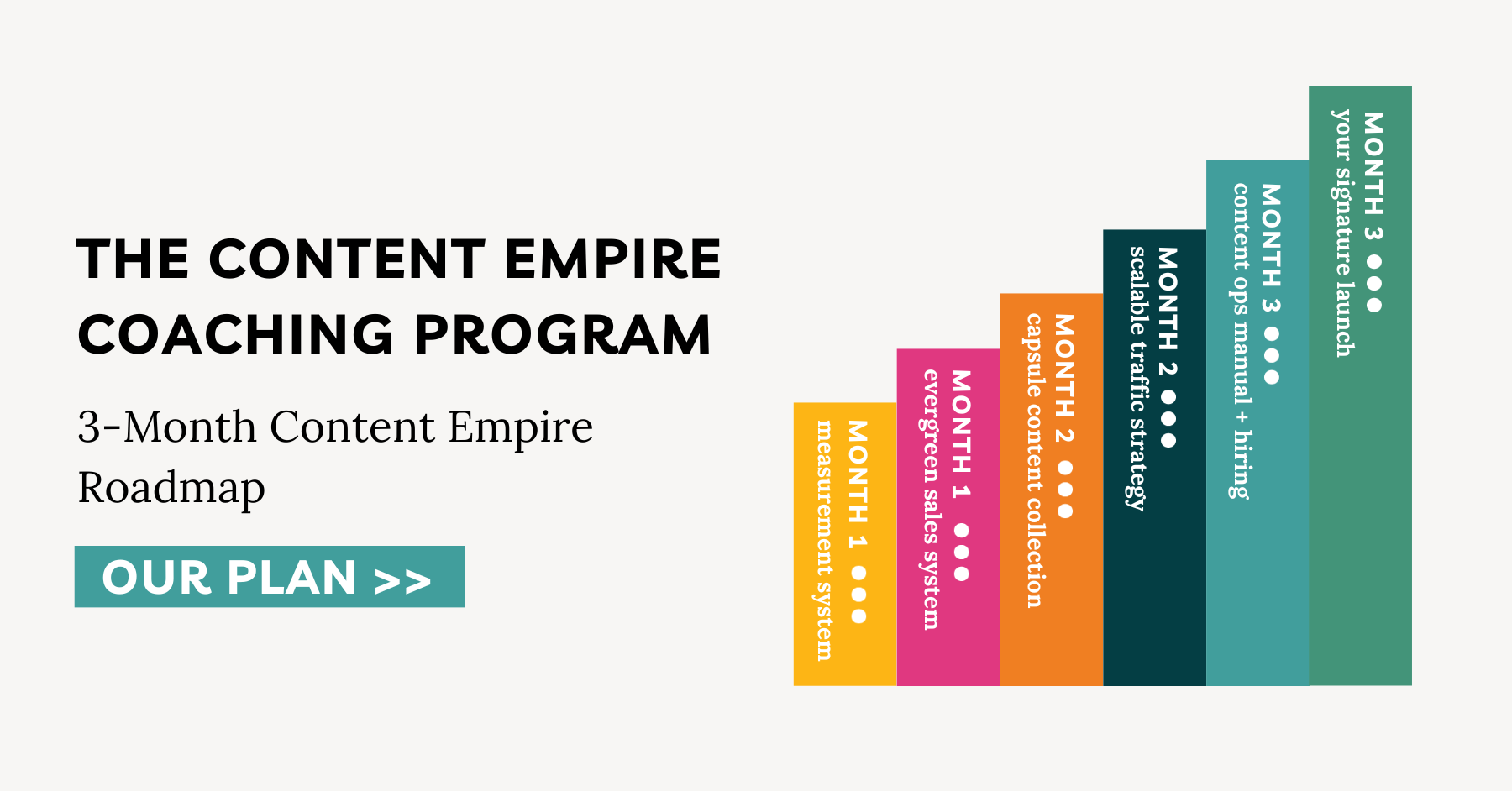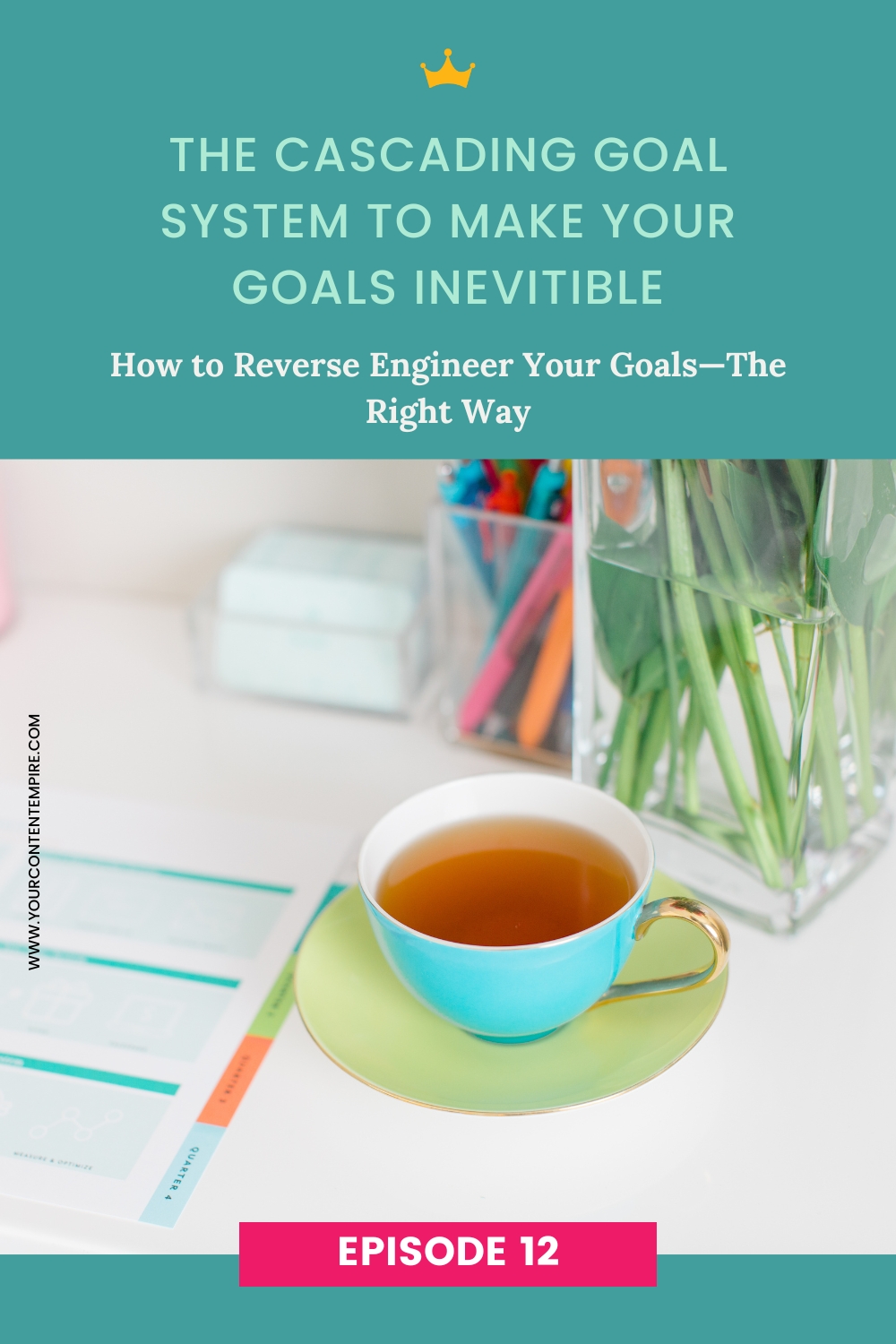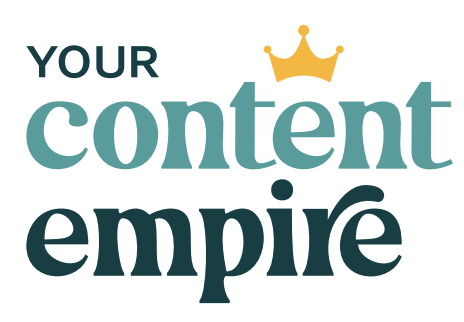Struggling to achieve your goals? Discover the Cascading Goal System to transform your big dreams into actionable steps.
Here’s an overview of what we’re chatting about:
✅ Cascading Goal System: A method for achieving goals by reverse engineering projects, focusing on priorities and aligning them with overarching objectives (think of it like a goal puzzle, where each piece fits together).
✅ Decision Matrix: A tool for evaluating project ideas based on urgency, impact, and alignment with goals, aiding in making informed choices (like a scorecard for your ideas).
✅ Accountability and Flexibility: Mixing a bit of accountability (your personal goal cheerleader) with the flexibility to shuffle things around when life throws curveballs.
Get 1-1 Support With Your Content Empire:

FULL TRANSCRIPT (CONTENT HORROR STORIES):
Welcome back to the Content Coffee Break podcast. I'm so excited to be talking about the cascading goal system. It's something that I have been using myself for years to make my goals and my projects all but inevitable, unless something like major shifts in terms of priorities or something else occurs. But for the most part, it pretty much guarantees I will make it to the finish line, unscathed, with my goal or project completed. And it's something that I have brought into the coaching program, first through the mastermind that I've run for over eight years, and now through my one-on-one coaching. So, we are currently enrolling for the coaching program, the Content Empire Coaching Program. We're enrolling for Q1.
And the first thing that we typically do in the coaching package is a planning intensive. So, regardless of when we're enrolling, we open that up, and it's about 90 minutes. We start with that so we can get really, really clear on all of the priorities and the project plan, and how we're going to get there, what might come up, and just to help you prioritize. Because, like, I'd rather you work on fewer things and get them to the finish line.
I talked about it in my email this week, around the idea of thousand-dollar tasks versus $10 tasks and hundred-dollar tasks, and all these ways that we maybe waste time as the owners of our business. We keep ourselves stuck, and we keep ourselves from growing because we're so focused on putting out fires or doing little admin things that really don't add up to having a whole lot of value. And so, with that, what I want to encourage you to do is spend more time on those thousand-dollar tasks.
And like, in addition to that, we also want to make sure those thousand-dollar tasks don't really mean anything unless you're shipping the project and finishing the project. Then, so we want to turn those thousand-dollar tasks into hundred-K-plus projects by actually getting those projects finished. And by focusing on less, we're going to be able to do that. So, like I said, I'm enrolling right now for Q1, and there's actually a bonus planning intensive. And this is different. I only do this for when we're enrolling for the new year. And this is where we have an additional 90-minute planning intensive.
This is going to be in December or very, very early in the new year, if we're not able to find a time that works with your schedule. And the whole purpose for this one, so instead of our normal 90-minute intensive, where we focus on the upcoming goals and getting really, really laser-focused on what those things are, what the project plan is, et cetera.
We are focusing on the overall picture of 2024 for you. And what are all of those projects that could be slotted into Q1, Q2, Q3, Q4, and how they're going to work together and how we're going to use this cascading goal system, which I'm going to be talking about today, in order to reach those goals.
So, very special little bonus here with an extra 90-minute intensive. Instead of getting laser-focused, we're thinking big picture in those intensive calls. And like I said, we're enrolling right now for Q1. I do open up enrollment a few times a year, and in between, there will be a wait list.
So you could always, when enrollment closes, which is at the end of the month, go and join the wait list. And as soon as a spot opens up, I will reach out to you, or when we're enrolling next, you'll be the first to know. So, I want to talk today about the cascading goal system. It's one of my favorite things, and there are really three parts to it.
One is picking your goals. The next one is creating that cascading goal system. And then our third element, one that's often missed, like, “Okay, I plan. I'm ready to go,” is increasing the odds for your success. So, I want to start with picking your goals. So, I mentioned a little bit about how I prefer to work on less.
I call it start less finish more because those big, important thousand-dollar tasks don't really add up to anything unless you're actually shipping the project. And so, if we focus on fewer projects, usually I recommend my clients focus on three to five, depending on capacity. Right? If you have a team who is helping you execute things and implement things, or if you just happen to have like, you know, “I'm blocking off my quarter to work on these things, and I'm not working on a ton of other things at the same time, like client work, et cetera,” then, you know, you'll have a slightly higher capacity and be able to maybe tackle more. But we get really clear on those things when we're picking those goals.
So, the first thing is, we want to make sure we take a look at your goals and we want to reverse engineer the projects that you're choosing – the three to five projects that you're choosing for the quarter – based on what those goals are, so that we make sure that all the projects we're not just picking shiny objects here, but we're actually making sure they support that goal, right?
That overarching goal that you have. And what I find is, like, people often jump into projects and they'll get really distracted and off track. And they'll wonder why, at the end of the year, they haven't reached their goals. And really it comes down to the fact that they were just picking projects and working on things that maybe weren't, you know, in alignment with those goals.
So, if you were having trouble deciding, another email that I sent out this week was around the decision matrix. And next week, we are talking to, oh, I have a really special episode next week with Lauren Black, who is a decision expert, all around how to, you know, put off shiny object syndrome when it comes to investing in your business and making really solid decisions.
However, I've been using this decision matrix forever. It's like a cornerstone in most of my projects. Right. I like to, as a chronic recovering overthinker, like deciding for too long around making decisions and overthinking everything with them, you know, I've really become quite decisive.
And one of the tools that I have in my toolkit is the decision matrix. And when it comes to projects, what we want to do is have you brain dump all of the project ideas. We make sure they're in alignment, and then we go through and we give it a score, one to ten, on three different criteria.
Number one is how timely this is, right? Is this something that is urgent? Is this something that can wait? Is this something that I need to tackle other things first before I can get to it? So that's deciding factor criteria, number one. The second one is in terms of impact. So, what is the potential impact of this project?
So, is it going to have a big impact on my goals? Is it going to make a big impact in terms of ROI? Is it time well spent, essentially? And then the third criteria score, one to ten, is around the idea of alignment. So, how in alignment is this project with the goals that you are working on?
So, give it a score, one to ten, and then you'll eventually have all of these scores there. You'll be able to tally them up. They'll have a score between three and thirty, and then you're going to be able to rank them in terms of importance, based on that score. You can also always trust your gut here.
If there's something, even though the numbers aren't showing and you want to go with it, uncover why, right? Why are you still thinking that this is a good idea? Maybe there's something that needs to be reworked in terms of the scoring matrix. But for the most part, that should give you a lot of clarity on which projects to move forward and actually finish in the upcoming quarter. So, that's number one, picking your goals.
Our second area here that we're doing is creating this cascading goal system. And I love this. Like I said, I've been using this for years and years and years. And it is something that, you know, helps me focus on the input rather than the output. And it almost always gets me to the finish line when I want to be there.
And so what we do here is we want to take your goals and reverse engineer your projects. And then from there, we're looking at the quarter, breaking it into months or into sprints. So what needs to happen each month of the upcoming quarter or each month of your sprint? In our coaching package, it is a three-month package, and we break it into sprints, right, of the month each.
And then after you have what needs to happen in each of these months, we want to break it down even further: what needs to happen each of these weeks in order to reach that monthly milestone, and then what needs to happen daily as well? So when it comes to months, which in our case, our sprints are four-week sprints, we want to come up with our list of priorities, our list of milestones or project milestones that we want to be reaching by the end of that month. And, you know, you might have something, right? If you have three or four different goals, you might have, you know, you can decide to be like, “I'm going to focus on goal one for sprint one, month one. I'm going to focus on goal or project two in sprint two.”
Right? So there are a few different ways it's tailorable to you. What we definitely look at in that first call is like, what is your particular project style? Are you someone who likes to work on a bunch of different things at once so you don't get bored? Are you somebody who likes to focus all in on one thing?
So we'd tailor that to you and how you're going to tackle it. And then we look at weekly. So what needs to happen each week of the month in order to get you to that finish line by the end of the month. And we also want to look here at the things that maybe need to happen weekly. Right?
So we're looking at both one-time actions, the weekly milestones, as well as the weekly routines and recurring tasks. We do the same thing with daily. And usually, that's on a recurring level. What needs to happen on a daily basis to kind of inch your way forward. One of the tools that we pull out a lot, especially since this is focused on content marketing projects, is our daily content habit.
Right? So what are your daily little writing sprints that you could do to move you closer to writing a big project or writing something big there? So that is creating the cascading goal system. I go into it in a lot more detail in those projects, in those planning intensive calls. And then the third element is increasing the odds of success.
And so we want to look at a few different things here. So one of the first tools that I use in terms of increasing the odds of success is the idea of a premortem. And I learned this from Tara McMullin, who brought up this concept around thinking about all the things that could go wrong, all the things that could get in your way of successfully completing the goal.
And it could be, you know, “I'm going to run out of time.” It could be, “I'm going to get, you know, this other thing might happen and I might need to switch course or direction.” And we want to, like, pre-plan what you're going to do in the case of that thing happening or, “What if I'm going to get low clicks?”
Right. What can I do to address that thing? So we want to start thinking about, we want to go to the worst-case scenario for just a minute here, and come up with the ideas of what we can do preemptively or when those things start to happen. Then we want to make sure we add in some flexibility. So, what if you miss one week and we're all of a sudden off on your cascading goal system? How are we going to make up time?
Why are we going to shift things? Are we going to extend the deadline? Are we going to simplify and get back to it? So that's one of my favorite things to do. And one of the things I have there is a flex day built into that cascading goal system to help you stay on track. The next thing is getting accountability.
Right? But you certainly can use this cascading goal system without working with me in the coaching program. However, you know, getting that accountability, you know, you might think, “I don't really need that, or I can do this on my own,” but I ask you, like, how many of those hundred-thousand-dollar projects are you shipping?
Are you launching per quarter? And if the number is low, you might need to bring in some more accountability, whether through the Content Empire coaching program or something else. It could be an accountability buddy as well. So, in conclusion, I want to know what you're working on in 2024. And if you want to learn more about coaching, come over to yourcontentempire.com/coaching.
And if you have any questions, you definitely know where to find me, over at Your Content Empire on Instagram. And until next time, keep creating content.













